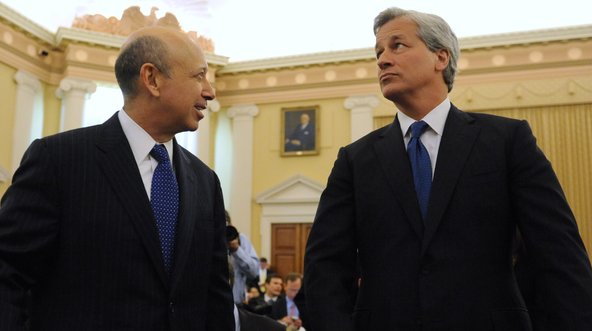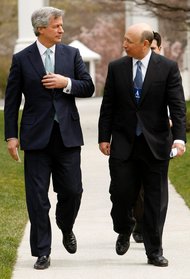 Michael Reynolds/European Pressphoto AgencyLloyd C. Blankfein, left, with Jamie Dimon in 2009.
Michael Reynolds/European Pressphoto AgencyLloyd C. Blankfein, left, with Jamie Dimon in 2009.
Jamie Dimon has consulted lawyers, public relation experts and bankers as JPMorgan Chase wrestles with the fallout from a multibillion-dollar trading loss. But the bank chief has received advice from an unexpected corner: Lloyd C. Blankfein of rival Goldman Sachs.
The two executives have talked privately a number of times in recent months about the challenges that Mr. Dimon is facing, people with knowledge of the relationship but not authorized to speak on the matter, have said.
JPMorgan is battling a shareholder vote on whether to separate Mr. Dimon’s positions as chief executive and chairman, and is also dealing with a number of regulatory investigations. The vote is coming to a head. Within the last week shareholders have been casting their ballots, but at least a handful of major shareholders have yet to vote, according to others briefed on the matter but not authorized to speak on the record.
The conversations between Wall Street’s two most powerful chieftains represent a reversal of roles. It is now Mr. Dimon who is in a harsh public spotlight, seemingly at odds with regulators. It was not long ago that Mr. Blankfein was being questioned by Congress over accusations that Goldman had misled investors during the financial crisis over the sale of mortgage-backed securities.
Now, with Goldman cleared of crisis-era investigations and its profits rising, Mr. Blankfein is enjoying something of a renaissance as an elder statesman of Wall Street.
“I would call them foul weather friends,” said one person with knowledge of the relationship who was not authorized to speak on the record.
JPMorgan’s Trading Loss
 Kevin Lamarque/ReutersMr. Dimon, left, who is facing scrutiny, and Mr. Blankfein after a White House meeting on the economy in 2009.
Kevin Lamarque/ReutersMr. Dimon, left, who is facing scrutiny, and Mr. Blankfein after a White House meeting on the economy in 2009.
Foxhole buddies might be a better metaphor. Both executives steered their firms through the tumult and panic of the financial crisis.
Yet while the JPMorgan chieftain emerged from the crisis hailed as Washington’s favorite banker, Goldman’s chief was cast by many as a villain.
Having survived that trial by fire, Mr. Blankfein is advising Mr. Dimon that the current storm will eventually pass, just as it appears to have done so for Goldman, the people with knowledge of the relationship said.
Goldman’s experiences does offer lessons. At a recent meeting of top financial services industry executives, Mr. Dimon asked a small group of people, which included a top-ranking Goldman executive but not Mr. Blankfein, how Goldman managed to avoid having to put forward to shareholders a vote on whether to split the job of chairman and chief executive, according to one attendee and others briefed on the conversation.
Goldman, one person explained to Mr. Dimon, worked hard behind the scenes with its shareholders to head off such a vote, persuading them that the firm had a strong, independent lead director on its board.
While the consultations may be recent, the two men — both native New Yorkers — have long had a cordial relationship. Both are members of the Financial Services Roundtable and they have crossed paths at Manhattan fund-raisers, like the annual dinner of the Robin Hood Foundation, which raises money to fight poverty in New York City.
When together, they often try to outwit each other, said one person who has seen the two in action. At a meeting a few years ago, the person recalled, Mr. Dimon responded to a comment by Mr. Blankfein by asking, “Lloyd, are you still trying to do God’s work?” a reference to an oft-quoted remark the Goldman chief executive made to a reporter in 2009.
People close to Mr. Blankfein, who turns 59 in September, and Mr. Dimon, who is 57, emphasize that when the executives talk it is typically on a variety of issues, and it would be unusual for a call to be focused solely on Mr. Dimon’s current situation.
The shareholder vote and questions about Mr. Dimon’s leadership have come about even as the bank has generated a string of record quarterly profits. On Tuesday, a JPMorgan executive told a conference that trading revenue was running 10 to 15 percent higher this quarter, compared with the second quarter a year ago.
Yet the bank continues to be haunted by the trading losses at its chief investment office in London more than a year ago. JPMorgan has moved to put the problem behind it, firing traders at the center of the disastrous bet, seeking to regain millions of dollars in compensation and reshuffling its executive ranks.
But investigations and a Senate report and hearing that accused the bank of misleading investors and regulators have kept the spotlight on the bank. Other investigations have raised questions about the bank’s controls and relations with regulators.
Paul A. Argenti, a professor of corporate communications at Dartmouth’s Tuck School of Business, said that while JPMorgan did an excellent public relations job handling the trading losses, the bank’s public relations strategy is not enough to tackle the broader issues.
“This has ceased to be about the ‘Whale’ and it’s become about whether you can trust this institution and this executive again,” he said. Now, Mr. Dimon is bracing for the outcome of a looming vote that could threaten his position as JPMorgan’s chairman and chief executive, dual roles he has held since 2006. The nonbinding vote, which will be announced on May 21 at JPMorgan’s annual meeting in Tampa, Fla., is expected to be close. In 2012, 40 percent of shareholders voted to split the two roles.
Still, JPMorgan says despite the travails of the last year, surveys show customers are still happy with the bank. JPMorgan ranked No. 4 in the nation for customer service, in J.D. Power’s latest tally, and top among the nation’s largest banks.
And the bank may take comfort in Mr. Blankfein’s counsel that Mr. Dimon will cycle out of the headlines.
Mr. Blankfein has had a public image makeover, thanks in part to initiatives by Goldman. After the financial crisis, Goldman announced new charitable efforts, started an advertising campaign and showed an increased willingness to engage with the media.
Then, earlier in 2012, it hired Richard Siewert Jr., a former White House spokesman and counselor to former Treasury Secretary Timothy Geithner.
Article source: http://dealbook.nytimes.com/2013/05/14/in-role-reversal-goldman-chief-advises-dimon/?partner=rss&emc=rss